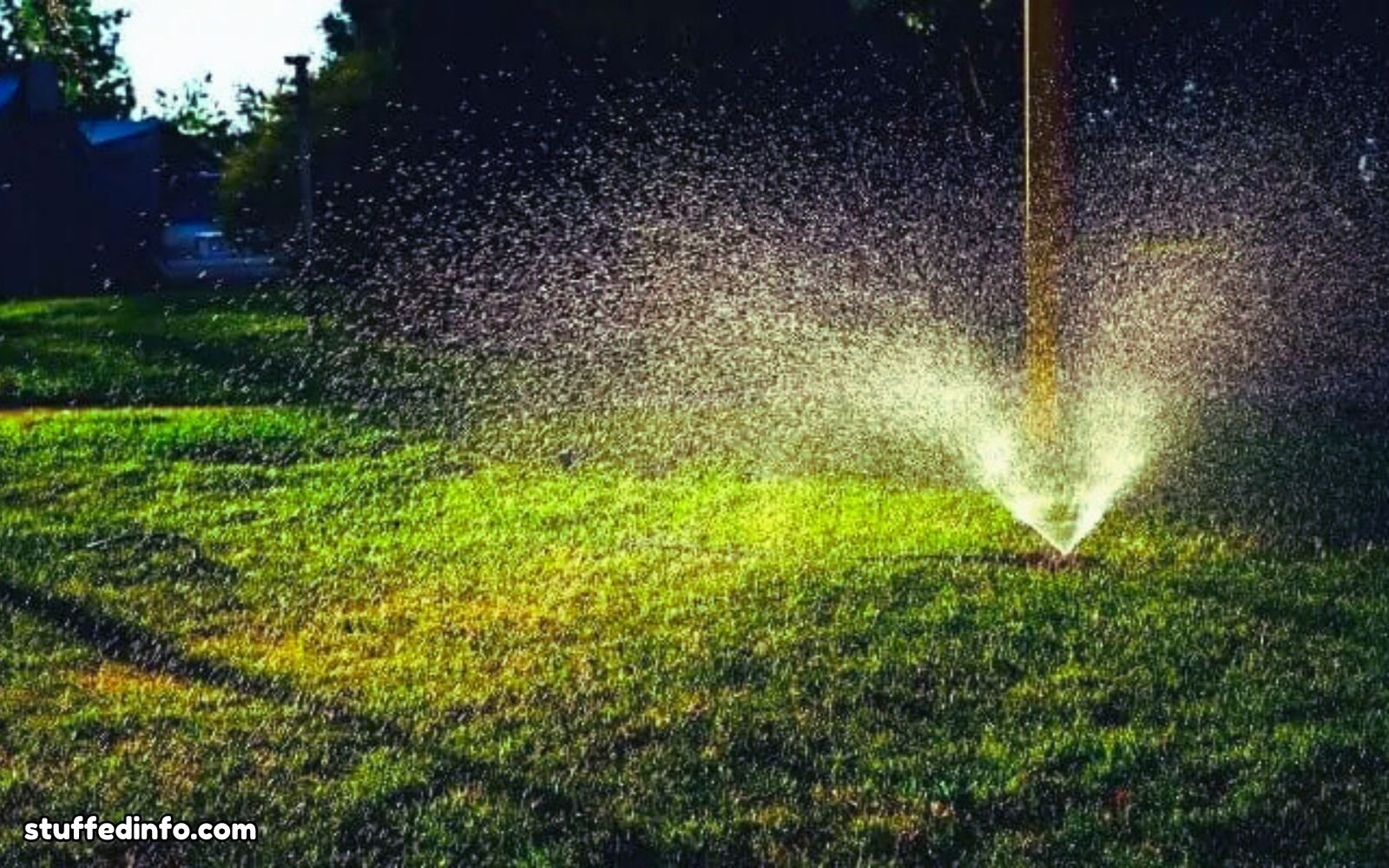Watering your lawn might seem like an easy task, but the timing is super important. Also, you might be really focused on making sure your lawn gets enough hydration. But surprisingly, knowing the worst time to water grass is more important. This is because by getting the timing right, you’ll keep your grass looking green and healthy all season. Let’s check out why timing is key, the worst time to water grass, and some smart techniques to make the most of every watering session.
Table of Contents
ToggleWhy Is It Important to Water Grass Properly?
If you want a lawn that looks great and stays healthy, watering your grass the right way is super important. So, let’s explore why proper watering really matters!
- Helps Roots Grow Strong: Proper watering boosts the growth of stronger and deeper roots. This means your lawn can handle heat, drought, and annoying pests much better.
- Keeps Soil Loose: Watering the right way keeps the soil from getting too packed down and helps the good microbes in there thrive.
- Conservation: Watering the right way helps you make the most out of water, cutting down on waste and saving this precious resource.
- Even Growth: Watering constantly helps stop those annoying dry areas and makes sure your lawn looks nice and even.
Since the benefits of watering the lawn the right way are clear, let’s do the important part. Now let’s check out the worst time to water grass that might actually hurt your lawn.

The Worst Time to Water Grass
Steering clear of the worst time to water grass can really help your grass absorb the water it craves without wasting any or harming it. You might not know that some popular watering times—like during the day or at night—are actually the worst times to water your lawn. Here’s the scoop:
1. Midday: Avoid Watering During the Hottest Part of the Day
Watering your grass in the middle of the day might seem like a great idea, but it actually makes the water evaporate quicker than your lawn can soak it up. This results in:
- Wasted Water from Watering: When the water evaporates so quickly, less of it gets to the roots, which means you’re wasting water.
- Grass Stress from Watering: Water droplets on grass under direct sunlight can behave like little magnifying glasses, resulting in patches of grass that are discolored or burnt.
So, avoiding midday grass watering is your first move toward a healthy lawn, but evening watering comes with its own issues. Let’s explore why evening grass watering can also be a problem.

2. Evening: Avoid Watering Before Nightfall
You might think that watering your grass in the evening is a good idea to dodge the heat, but watering your grass at night can actually turn your lawn into a hotspot for fungal diseases. Here’s what’s up:
- Higher Chances of Lawn Disease from Watering: Leaving water on your grass overnight creates a damp environment that’s just right for mold and mildew to thrive.
- Attracting Pests: Wet, cool grass can lure in pests, which can end up damaging your lawn over time.
On top of that, we’ve talked about watering in the middle of the day and the evening, but there are also certain environmental factors, like windy conditions and freezing temperatures, that can mess with your lawn if you water at the wrong time. Let’s dive into those next.

3. Windy Conditions
You might think wind is no big deal, but when it’s really breezy, watering your lawn can be tricky. The wind blows those water droplets around, making it hard to water evenly and leading to water waste. Here’s why you should think twice:
- Uneven Watering Coverage: The wind sends the water flying, leaving some spots dry and others too wet.
- Water Waste from Watering: If the wind takes your water away from the grass, you’re basically just wasting it.
To deal with this, just check the weather and wait for a calmer day so your lawn gets the right amount of water where it counts. Now, let’s talk about freezing temps, which can really mess things up if you’re not careful.
4. Freezing Temperatures
Watering your lawn when it’s freezing outside can cause damage that’s hard to fix later:
- Ice Crystals on Grass Blades: When water freezes on the grass, it creates ice crystals that can hurt the blades.
- No Soil Absorption: If the soil is frozen, it can’t soak up the water, leaving it sitting on top where it can cause more trouble.
In summary, now that we know when not to water, let’s talk about the best time to water your lawn and why it’s super important to water in the morning.
The Best Time to Water Your Lawn
So, if the worst time to water grass is clear, then when’s the best time to water? Well, it’s pretty straightforward: the early morning hours, right after dawn, are the perfect time to water your lawn. Here’s why watering in the morning is revolutionary:
- Lower Evaporation Rates: When it’s cooler, the water gets a chance to sink into the soil instead of just disappearing into the air.
- Encourages Deep Root Growth: Watering in the morning gives roots the nudge to dig deeper, making your grass tougher.
- Prevents Fungal Diseases: As the sun comes up, grass blades dry off, cutting down the chances of grass fungus from too much watering.
To sum it up, watering in the morning is an important step, but there are also some other smart watering hacks that can help your lawn thrive. Up next, we’ll take a look at how to water smartly to prevent overdoing it and get the best outcome.
Factors to Keep in Mind Before Watering Your Grass
Many factors affect how often, when, and how much to water your lawn. Knowing this can help you create a routine. It will grow your grass healthy and green.
Grass Type: Different types of grass have different water needs. For example, cool-season grasses usually need more water than warm-season grasses.
Some cool-season grasses are:
- Kentucky Bluegrass
- Fescue
- Perennial Ryegrass
- Buffalo
Some warm-season grasses are:
- Bermuda
- Zoysia
- Centipedegrass
- St. Augustinegrass
- Seashore Paspalum
Soil Type: The kind of soil you have also affects how you water your grass. Soil type influences how much water it holds and how well it drains. Knowing your soil type helps you water your lawn. It tells you how deep and how often to water for the best results.
For example, you might have sandy, clay, loamy, or silt soil. You can even have acidic or alkaline soil. To get a clearer idea of your soil’s needs, it’s a good idea to do a soil test to check its pH and nutrient levels.
Climate: The weather around you plays a big part in your watering schedule. If you live in a place that gets a lot of rain, your lawn won’t need as much water. But in drier areas, you’ll need to water more often.
Also, certain weather conditions can affect when to water your lawn. It’s best to water during the dry parts of the day. But, if the sun is too hot, you might waste water through evaporation. Wind can affect how well your grass absorbs water. It’s usually calmer in the mornings, so it’s a great time to water.
By considering these factors, you can keep your lawn looking its best all year long!
Smart Watering Grass Tips
If you want to make your lawn super healthy, it’s key to water deeply but not too often. Let me explain:
- Keep an Eye on Your Lawn: Look out for signs like drooping or unusual colors. Thus, adjust your watering routine if needed.
- Grab a Rain Gauge: This handy tool tracks how much it rains. It helps you avoid watering more than necessary.
- Don’t Forget to Mulch and Aerate: These techniques help your lawn soak up water more effectively. That way, each time you water, it truly benefits your lawn.
- Water Deeply but Sparingly for Strong Roots: Less frequent watering encourages the roots to grow deeper. This practice enhances the overall look of your lawn.
- Watch Out for Overwatering: Too much water can actually harm your lawn. It creates an environment for diseases and pests that can cause long-term damage.
So, taking good care of your lawn really helps keep it looking lively and green.
Wrapping Up
To wrap things up, understanding the worst time to water grass and smart grass watering tips are equally important. Thus, keep in mind that nailing the right timing and methods is the key to having a lawn that’s not just green but also tough.
FAQ
- Should I change how I water depending on the season?
Definitely! When it’s hot in the summer, you might need to water more often. Similarly, in the chillier months, watering less frequently is usually enough.
- How long should I be watering my grass?
Shoot for about 1 to 1.5 inches of water each week, rain included. Depending on your setup, this could mean watering for 30 minutes to an hour.
- Are there tools that can let me know when to water?
Absolutely! Stuff like soil moisture meters can really help you figure out when your lawn actually needs water. You can also just grab a tuna can to check how much water your sprinkler is putting out.







